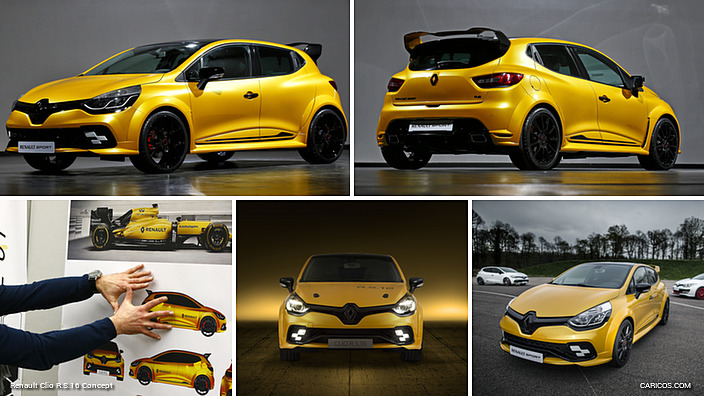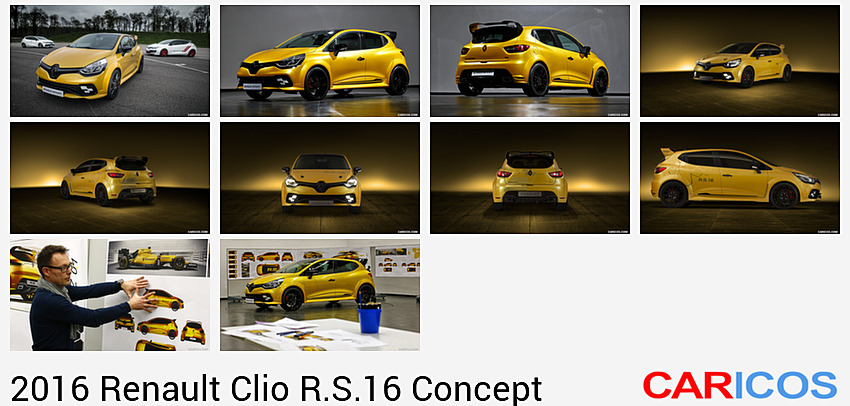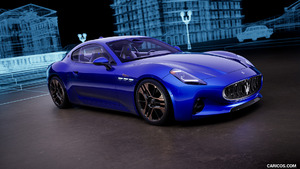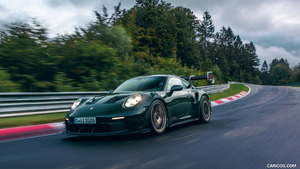Clio R.S.16 Concept
RENAULT SPORT EXPERTISE PACKED INTO A CONCEPT CAR
To celebrate its fortieth anniversary, Renault Sport is proud to unveil the concept car, Clio R.S.16. In under five months, teams from Renault Sport have worked to bring to life a somewhat crazy idea, which involved putting a 275bhp, 2.0-litre turbo engine developing 360Nm of torque under the bonnet of a Clio R.S.
To fully exploit the potential of this powerful engine, derived from Mégane R.S. 275 Trophy-R, Clio R.S.16 comes with chassis and suspension systems featuring solutions developed for racing. Boasting 19-inch wheels and a 60mm wider bodywork, its aggressive design only serves to confirm its purpose: become Renault Sport's most powerful road car.
Sharing its name and colour scheme with the R.S.16 single-seater, Clio R.S.16 celebrates Renault's return as a Formula 1 constructor. This Friday, 27 May 2016, Renault Sport Formula One Team driver Kevin Magnussen treated fans and onlookers to the first public outing of Clio R.S.16 at the legendary Monaco Grand Prix.
Where it all started
The idea that led to the creation of Clio R.S.16 took shape one evening in October 2015, during a brainstorming session organised at the head office of Renault Sport Cars. Managing Director Patrice Ratti met with the inner circle of his team to try and come up with new projects, especially in order to celebrate the fortieth anniversary of Renault Sport.
During discussions, engineer Christophe Chapelain asserted that a Clio chassis would be perfectly able to handle the performance levels of a 300bhp engine, based on his experience in rallying. One thing led to another and the idea of a Clio R.S. with exceptional performance gained ground.
 2016 Renault Clio R.S.16 Concept
2016 Renault Clio R.S.16 Concept
"We all recalled the impact made by Clio V6. We wanted to create a technical concept car with extraordinary performance levels but which was more realistically priced. We therefore had to keep our feet on the ground and use simple, ingenious solutions to achieve a vehicle that could be type-approved. Furthermore, we wanted this project to be entirely developed by Renault Sport," recalled Patrice Ratti. "In theory, a Clio R.S. fitted with our most powerful engine – the 275bhp, 2.0-litre turbo engine – was an attractive proposition, but we had to conduct more serious checks as regards its feasibility. In less than a month, a small team had completed a preliminary study that confirmed it was possible to house this engine under the bonnet. We therefore decided with Thierry Landreau, Technical Director of Renault Sport Cars, to take a gamble and actually produce this car. Overall coordination of the project was placed in the hands of François Ratinet, who led the 'commando' team, which I supervised."
Michael van der Sande, at the time Senior Vice-President, Renault Group Marketing, was also excited about the idea. Renault was studying its return to Formula 1 and Clio R.S.16 would further demonstrate the close ties between racing and production cars. At the end o December, Renault gave the go-ahead for the project.
“Without giving away all our secrets, I can tell you that we'll have a great surprise for everyone at the Monaco Grand Prix. They will see just how Renault Sport makes the connection between the racetrack and the road.”
Jérôme Stoll – President of Renault Sport – 3 February 2016 Launch of the Renault Sport Formula One Team
It was decided that Clio R.S.16 would be unveiled to the public on Friday, 27 May 2016, at the Monaco Grand Prix. This deadline determined a large part of the project, which therefore had to be completed within just five months!
“For this project, the racing engineers have introduced new working methods. With the main constraint being the tight deadline, our teams managed to learn to do without the numerous iterations that are typically involved in designing a production car, while still maintaining the same levels of quality and performance. In future, our aim will be to use this experience to design other slightly crazy cars, which will help us to add to our expertise whilst exploring new avenues for the future.”
Patrice Ratti – Renault Sport Cars Managing Director
A commando unit
A team of a ten or so people was put together in early January at Renault Sport. The project was entrusted to the Preliminary Project unit, a Prototype Build Centre department.
"The premise was to design an exclusively Renault Sport vehicle, fitted with the most powerful engine in the range," explained Laurent Doré, Manager of the Prototype department. "The aim was perfectly clear, but the first difficulty concerned the lead-times, which were extremely tight. We created a team made up of experts from Renault Sport Cars and Renault Sport Racing. This little ‘commando’ unit was managed by Maurizio Suppa, an engineer specialising in prototype design. "
Whilst remaining independent, the Preliminary Project unit could nonetheless use the many skills found at the Les Ulis and Viry-Châtillon sites (Essonne). The project immediately garnered the support and enthusiasm of all of those involved in the project.
Many challenges to be met
Aside from the time constraints involved in completing its work, the Preliminary Project unit quickly identified the major challenges posed by the specifications. Firstly, it was a question of correctly positioning the engine, gearbox and cooling system taken from Mégane R.S. 275 Trophy-R.
With some 360Nm of torque, the engine required the powertrain suspension to be altered, and the teams came up with an inventive solution, combining and adapting parts taken from the production Mégane, Kangoo and Espace.
In order to provide optimum cooling, considerable simulation work was done in conjunction with the design engineers, who were tasked with revising the front end of the vehicle. These calculations were also intended to define settings that would enable Renault Sport’s trademark impeccable road-holding to be maintained.
Another key element as regards performance, the exhaust system had to be revised to meet the engine's output requirements. Without changing the route of the exhaust line under the car, the increased permeability of the system enabled the engine designers to meet their targets. The acoustics were not overlooked either: following track testing, Clio R.S.16 was fitted with an Akrapovič twin-exhaust silencer, which produces a rather pleasant sound. Although it isn't the most visible point, the electronics also required careful consideration, because the systems used on Mégane R.S. 275 Trophy-R and Clio R.S. are not based on the same architecture. Engine data is, however, essential in ensuring the ABS and ESP work properly, and vice-versa. The challenge was met by incorporating gateway software in the ECU of Mégane R.S. 275 Trophy-R, which interfaces with Clio's systems.
Chassis and suspension systems that deliver their full potential
With some 35 years' experience at Renault Sport, Pascal Auffrère was asked to work on the design of the front axle: "This project was given to me because I've been here for such a long time. Having worked on rally cars until the mid-90s, I moved over to production cars when we began designing Clio II Renault Sport. The Clio R.S.16 project was exhilarating because we had to work extremely quickly to produce a car with exceptional performance levels. It was easy, really, that was all I thought about! When conducting research and preliminary studies for a front axle capable of handling the stresses created by the power and torque of the engine, our knowledge of what had already been done at Renault Sport helped to save time. We started with the independent steering-axis front suspension, for which we designed a new stub axle. Cut from the block, this beautiful aluminium part enabled us to obtain the suspension layout we were after and to align it with the positioning of the steering."
Clio R.S.16's damper system uses Mégane R.S. 275 Trophy-R's one-way adjustable shock absorbers, with sliding cartridge. The braking system is also derived from Mégane, with 350mm-diameter steel discs fitted on aluminium bowls.
"Generally speaking, we tried to reuse the innovations that were introduced on Mégane R.S. 275 Trophy-R," emphasized Maurizio Suppa. "For example, we used a lithium-ion battery, which saved around fifteen kilos and space in the engine compartment!"
The design of the rear axle proved to be much more straightforward, because it was taken from Clio R3T, the rally version of Clio R.S. "In line with FIA regulations, we started with the production component, which was reinforced by a series of joint-welded bulkheads. To cope with the stresses of the roughest gravel rallies, we have increased roll rigidity by over 50%. We are therefore certain it will prove an effective solution for Clio R.S.16 on the road," detailed Christophe Chapelain.
Another major challenge arose when trying to work out how to fit 19-inch wheels on a bodywork designed for 18-inch wheels. The solution involved trimming the wings slightly, which were then fitted with composite fibre flares.
Clearly, all this technology must be contained within a cover that reflects the ambitions of Renault Sport. The exterior design of Clio R.S.16 was highly important, not least because it had a significant influence on the cooling performances of the car.
Designed for performance
The design of Clio R.S.16 was determined by two elements imposed by the technical specifications: the widening of the bodywork by 60mm and the switch to 19-inch wheels.
"When we saw the wording of specifications, we knew from the start that this project had good DNA," enthused Eric Diemert, Design Director for Renault Sport Cars. "For a car the size of Clio, widening the wings by 60mm is considerable. The use of 19-inch wheels was equally excellent news. We're always interested in bigger wheels, as this helps to offset the visual mass effect that is inherent in the raised bonnets of modern cars. The wheels are the only part of the car in contact with the ground, so they are critical in maintaining – or even boosting – the overall dynamic feel of the car. Clio R.S. was designed as a versatile car; its undeniably sporty handling was meant to contrast with its slightly more restrained looks. Clio R.S.16 retains this approach, showing a more spectacular side in its proportions and treatment, but stopping short of adopting a totally extrovert personality. That's what I like about this balance: demonstrate its qualities in a clear, obvious manner, without artifice."
Expressing new levels of dynamism and sportiness…
Drawn by the wording of the changes to be made to the car, designer Franck Le Gall starting looking for building blocks that would enable Clio R.S.16 to maintain the dynamic feel of Clio R.S., whilst allowing it to express itself.
As the time available meant it was impossible to create a complete mock-up, the modifications were simulated using modelling software. In order to fit the 19-inch wheels, it was decided to widen the bodywork by first trimming the wings and then adding composite fibre extensions. These flares were extended by sculpted side skirts placed as close as possible to the door sills to accentuate the car's racing spirit.
Few changes were made to the rear of the car. The diffuser, which contributes to the car's aerodynamic efficiency, has been supplemented by a spoiler taken from Clio Cup. Using Computational Fluid Dynamics (CFD) and extensive wind tunnel testing, the spoiler provides an additional 40kg of downforce at 200kph.
The interior design places greater emphasis on a sporty feel, with the installation of bucket seats and six-point safety harnesses. The rear bench seat and the air conditioning have been removed to reduce the weight of the car.
Following this modelling phase, the quick prototyping tools enabled a mock-up of the specific bodywork parts. Once positioned on a Clio R.S., they gave a good idea of the finished look. Only a few minor modifications were necessary to move closer to the final result, which was approved by Laurens van den Acker, Senior Vice President, Renault Corporate Design.
Spotlight on R.S. VISION
One of the most famous Renault Sport cars, Clio R.S.16 also stands out thanks to its additional LED lighting signature, R.S. VISION. With its chequered flag design, R.S. VISION is the most immediate reflection of Renault Sport's graphic environment. The exclusive multi-reflector LED technology enables the fog light, cornering light, headlight and side light functions to be grouped together.
A revamped front end for improved cooling
The quantity of fresh air delivered to the engine by the front end is one of the key elements that determine performance. The designers must factor this aspect into the design from the very early stages.
In order to ensure the air-to-air exchanger taken from Mégane R.S. 275 Trophy-R works properly, the front bumper's splitter has been redesigned.
This solution is both elegant and clever, since it involves no major visual change. The newlyadjusted bumper has been supplemented by a specific convergent. Maintaining the kevlar texture, this part emphasizes the high-performance character of Clio R.S.16.
"Industrial design only makes sense when you have to contend with constraints and you are involved in drawing up all the parameters that structure the design. In order for a project to make sense and get off the drawing board, all sorts of feasibilities have to be factored in. We are at the crossroads of these constraints and that's what makes this job exciting."
Éric Diemert – Design Director, Renault Sport Cars
Graphics inspired by the Formula 1 race car
Clio R.S.16 features the famous Liquid Yellow paintwork that is synonymous with Renault Sport and which adorns the Renault Sport Formula One Team cars in 2016. It is combined with Gloss Black on the front grille and diamond logo, as well as on the roof and outer surface of the rear spoiler. The paintwork on the upper surface of the spoiler is Liquid Yellow on the final version, in order to underline the sporty profile of Clio R.S.16.
In keeping with the racing spirit that is omnipresent on Clio R.S.16, the Speedline Turini wheel rims are black. Heavily perforated, they contrast with the red Brembo brake callipers. Clio R.S.16's look is completed by Renault Sport markings on the roof and a pixelated version of the Renault diamond logo from the back of the car, a feature it shares with the Formula 1 R.S.16. Obviously, this combination of yellow and black was chosen to mirror the livery of the Renault Sport Formula One Team's R.S.16!
Lightning quick tuning
The very first road test of Clio R.S.16 was held on Friday, 1 April, at the Montlhéry track. Thanks to the extensive simulation work done beforehand, the car immediately proved to be well-balanced. The other source of satisfaction concerned the temperature of the powertrain, which was in line with the initial specifications.
Following this initial shakedown, fine-tuning of the powertrain could begin. At the Lardy Technical Centre, climatic roller bench tests enabled the adaptation of various parameters to be confirmed. In order to be meet the project deadlines, which remained very tight, this stage was performed by engineers that had worked on the tuning of Mégane R.S. 275 Trophy-R: Jean-Sébastien Robert and Frédéric Laurent.
Ten days after the first on-track outing of Clio R.S.16, handling fine-tuning and convergence began on the Aubevoye Technical Centre's tracks. At this confidential, strategic site in Normandy, Clio R.S.16 rubbed shoulders with the prototypes of forthcoming Renault vehicles.
Two cars were built by the Preliminary Project unit: the Liquid Yellow model will be the concept car unveiled at Monaco, whilst the Deep Black model serves as the ‘mule’ for development testing.
It was decided to fit Michelin Pilot Sport SP2 tyres at the start of the project. This initial session could therefore be directly devoted to the mechanical settings of the axles. Like a racing team, the various options were reviewed: stiffness of the springs, valving and shock absorber stops, anti-roll bars, etc.
"The Aubevoye track allowed us to work near to our base in Les Ulis, in good conditions and in complete confidentiality," explained David Praschl, Clio R.S.16's development driver. "We chose a route that combined all kinds of difficulties: an uneven section with pot-holes to work on vertical lift, big corners to test road-holding, a hairpin to check traction, etc. We also used the speed ring to study stability at 200kph plus…"
The members of the Preliminary Project unit also attended this first test session to check that their choices were appropriate and think about future upgrades. At the same time, the engine designers analysed the gigabytes of data to check the 2.0-litre turbo engine was working properly and assess its performance levels… After three days of intensive testing, the mule returned to Les Ulis for disassembly and complete verification of the components. On 28 April, a second test session was used to set the technical definition after having fine-tuned the final details.
How it feels behind the wheel
"Behind the wheel, Clio R.S.16 very quickly proved to be very dynamic thanks to the qualities of its chassis and the Michelin tyres," detailed David Praschl. "The increase in torque was handled well by the independent steering-axis front suspension, but this was no surprise since it's a technology that has been developed and used by Renault Sport for the last ten years or so. If I had to compare Clio R.S.16 with Mégane R.S. 275 Trophy-R, I'd say that there is less inertia on Clio. This is makes sense, since the car is more compact. It is therefore easier for all types of driver to get to grips with. The agility and progressive response of Clio R.S.16 remind me of Clio III Cup, which was a very popular car among racing drivers. It is also safer due its stability and the efficiency of the brakes. You really can have lots of fun behind the wheel! Now, we just need to tickle the speedometer to prove that it is indeed the most powerful Renault Sport road car..."
The start of a new story
By unveiling the concept car at the Monaco Grand Prix circuit with Kevin Magnussen – Renault Sport Formula One Team driver – behind the wheel, Renault Sport emphasizes the purpose of Clio R.S.16: drive, either on the track or on the open road!
Furthermore, the cars that can be seen with it on the track are just some of the Renault Sport models that have inspired a love of driving throughout the generations: Renault 5 Turbo, Clio V6, Renault Sport Spider, Mégane R.S. R26-R and Mégane R.S. 275 Trophy-R.
Following this first public outing, its next appearance will be in Great Britain at the Goodwood Festival of Speed (23-26 June).
The design of Clio R.S.16 also reflects a new way of working between the Renault Sport Cars teams, who focus on production cars, and the Renault Sport Racing teams.
Technical specifications
ENGINE
| Type | F4R M 874 |
| Capacity (cc) | 1998 |
| Bore x Stroke (mm): | 82.7 x 93 |
| Number of cylinders/valves | 4/16 |
| Compression ratio | 8.6: 1 |
| Maximum power kW (bhp) EEC | 201 (275) |
| Maximum power speed (rpm) | 5,500rpm |
| Maximum torque Nm (m.kg) EEC | 36.7 |
| Maximum torque speed (rpm) | 3,000 to 5,000rpm |
| Injection type | Multipoint |
| Fuel | Super unleaded recommended |
| Catalytic converter | Production |
GEARBOX
| Type | PK4 manual |
| Number of forward gears | 6 |
| Speed in kph at 1,000rpm in 1st | 9.2 |
| in 2nd | 14.52 |
| in 3rd | 20.39 |
| in 4th | 27.55 |
| in 5th | 34.66 |
| in 6th | 41.96 |
STEERING
| Type | Production variable power-assisted steering |
| Full-lock turning circle diameter (m) | 10.93 |
Axles
| Front axle type | Independent steering-axis front suspension |
| Rear axle type | Clio R3T-type open-profile torsion beam rear suspension |
Wheels and tyres
| Standard wheel rims (") | 8.25J x 19 |
| Standard tyres (FR/RR) | 235/35 R19 91Y |
BRAKES
| Braking system type | Diagonal split |
| FR: Ø (mm) | 350 |
| RR: Ø (mm) | 260 |
DIMENSIONS
| Length (m) | 4.09 |
| Width with wing mirrors (m) | 1.73 |
| Height without rear spoiler (m) | 1.43 |
| Wheel base (m) | 2.59 |









